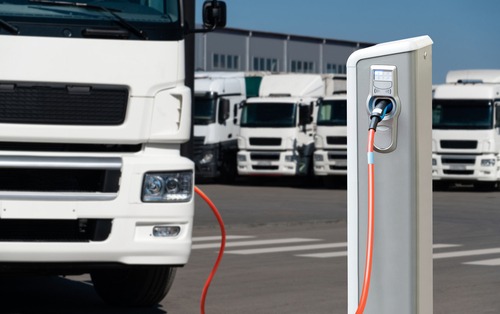
Commercial goods transporters say they want to buy electric medium- to heavy-duty trucks, but they’re waiting on technology and production to catch-up to demand.
U.S. Rep. Don Beyer (D-VA) stressed how important the move to electrify medium- to heavy-duty trucks is for the future of the transportation industry.
“This is the greatest transformation of the transportation industry since the combustion engine,” Beyer said on June 15 during a Bipartisan Policy Center event on commercial goods transport. “If we don’t do it, we’re in great danger from a fossil fuel industry that is inherently uncertain… and would limit our ability to compete globally.”
Beyer said the European Union was moving forward with a pledge to eliminate fossil fuels in commercial transportation. “This is going to happen with or without us,” he said.
During a virtual panel discussion, representatives of the commercial goods transportation industry said they are investing in alternative fuel methods for their fleets, but that suppliers can’t yet meet their needs.
Tiffany Nida, leader of the Middle Mile Fleet for Amazon, said her company’s climate goals include an electrified fleet.
“Amazon has two sustainability goals,” she said. “The first is Shipment Zero, where 50 percent of all shipments will be net carbon zero by 2030. The second is our Climate Pledge, where we want to be net zero carbon by 2040.”
As part of that, the company is exploring all avenues, including compressed natural gas, hydrogen and electrification as alternative fuel services for its fleet of delivery vehicles. Already, she said, the company has ordered 100,000 electric vehicles for its last mile fleet and anticipates having 10,000 on the road by the end of 2020.
For Thomas Jensen, senior vice president of transportation policy at UPS, his company is studying different fuel sources in an effort to test the efficiency, range and sustainability of each alternative.
“Efficiency is key,” he said. “UPS is committed to doing our job safely and sustainably more than ever before.”
But each company said they face challenges in moving to electrification. For UPS, the challenge is waiting for the market to catch up to its needs. Although the company has pre-ordered more than 10,000 vehicles, fulfillment of the order has been pushed back to 2022. Additionally, UPS has the largest single pre-order of Tesla all-electric semi-trucks, but again is awaiting delivery due to delayed production.
In addition to actually getting the vehicles, businesses face challenges in accessing electric vehicle charging stations.
“It’s not just that availability is still limited,” Nida said. “The charging infrastructure is also a challenge.”
Ryan Laskey, senior vice president of Dana’s Commercial Vehicle Drive and Motion Systems business unit,said another challenge was the workforce training to support and repair the vehicles.
“Everyone wants to get electric vehicles out there, everybody’s got pre-orders out there,” he said. “But we need to make sure we have after sales support and service … it’s one thing if you need to repair a diesel truck. There are a number of shops you can take it to to get it worked on. We need to have that service (for electric vehicles) in remote areas.”
Laskey said it was commercial vehicles that would drive the push towards electrification.
“As you start to look into the transportation industry, the companies that move from point A to point B… are looking to do it in the most efficient way possible to save money,” Laskey said. “They are the ones that will be driving the change.”
Ben Prochazka, executive director for the Electrification Coalition, said the question of whether commercial vehicles would move to electric is no longer a question of “if”, but “when.”
“The race to electrification is a global race that’s taking place right now,” he said. “And it’s critical that the U.S. maintain its leadership in the commercial transportation sector.”
And it’s important to move forward on electrifying the medium- and heavy-duty trucks in order to have an impact on the environment, he said.
“Commercial-duty and the freight sector has an out-sized impact on our emissions and on public health,” he said. “Freight vehicles may travel 40,000, 50,000, 60,000 miles per year. So even though they may be less than 5 percent of the total vehicles on the road, they have a huge impact on pollution.”
Getting there, Prochazka said, would require federal policy shifts, however. The coalition suggests that federal policies on commercial transportation electrification include three items: adjusting manufacturers’ credits for building vehicles that have a higher gross weight of over 14,000 pounds; expanding the EV charging tax credit to eliminate the cap on a per-site basis to encourage building the charging infrastructure; and providing funding for heavy-duty and medium-duty electric vehicle charging stations.
The panelists agreed that federal policy shifts were necessary to help not only larger companies, but smaller ones as well.
“Federal support is critical,” Jensen said. “People look at UPS and other large companies and wonder why they need help. But we do an awful lot of business with medium- and small businesses and those medium- and small-sized businesses need that assistance.”